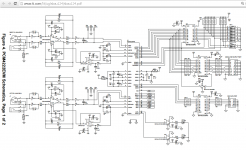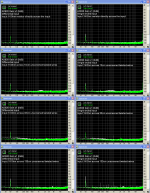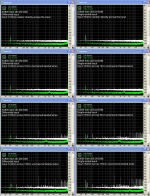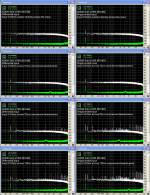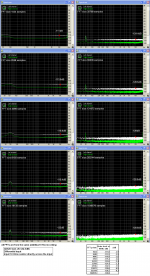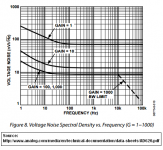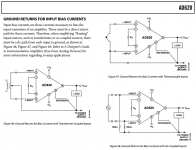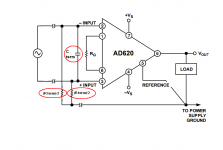I understand the need of many for declicking, denoising and metadata retrieval but I am interested on the backbone of the idea: flat preamplifier, DSP RIAA equalization, how to best achieve it (from an amateur standpoint) and acoustic comparison with the traditional way of doing the LP rip (analog RIAA and digitization).
As for my needs, bill said it there:
George
Yes first things first, the jury is not out on whether the flat gain/digital EQ is preferred by most everyone.
Looks good, does not appear to support ASIO.
It is an option under Sound>'Mixer Backend' but I haven't tried it on a system running ASIO yet.
Demian
Was it the straight through ADC that didn’t work well or was it the DSP equalization that didn’t do?
George
I did some extensive testing of ADC chips a few years ago including the TI and the ESS. The TI was pretty good with harmonics below -105 to -110. Te noise floor did start to increase above 20 KHz. The ESS chips were barely -90 dB harmonics. Much back and forth with ESS at the time but they never delivered on the promises. The Cirrus chips are all pretty old and do work OK. The AK5394A was really 10 dB better in harmonics and has a flat noise floor to 80+ KHz. The newer AKM chips sample at higher rates and even have DSD out but are less linear. The only chips I have seen with similar potential are the SAR ADC's, they aren't audio focused but Frex's efforts shows promise: http://www.diyaudio.com/forums/equi...ormance-audio-adc-project-ltc2380-24-a-6.html
However using one will vastly complicate a project like this and not bring significant benefits.
FWIW the AK5394a is used in a number of premium AD-DAs like Protools, Burl Audio, Lynx and EMU. The AK5385 which is similar is in the RME and ESI boards.
As the project spins and spins - I'll just put in a word for what I would want.
Balanced input-output preamp.
24/96 ADC or better
DSP for RIAA
Digital output (SPDIF or whatever)
That's about it.
Having software tools to tweak the overall response would be nice. Maybe a software rumble filter too?
Balanced input-output preamp.
24/96 ADC or better
DSP for RIAA
Digital output (SPDIF or whatever)
That's about it.
Having software tools to tweak the overall response would be nice. Maybe a software rumble filter too?
I use this adc.
PCM4222EVM - TEXAS INSTRUMENTS - Evaluation Module for 124dB SNR Stereo Audio ADC with PCM/DSD and Modulator Outputs | Farnell element14
and my own tube riaa preamp.
PCM4222EVM - TEXAS INSTRUMENTS - Evaluation Module for 124dB SNR Stereo Audio ADC with PCM/DSD and Modulator Outputs | Farnell element14
and my own tube riaa preamp.
Good idea. But it would need to be gain and load, wouldn't it?Maybe a gain switch for MM or MC?
It is an option under Sound>'Mixer Backend' but I haven't tried it on a system running ASIO yet.
I'll try it. I see they have a nice memory management scheme, that was one of the best things about CoolEdit. You could expand a 10hr. MP3 and scroll and edit it with virtually zero latency or redraw delay.
Attachments
Good idea. But it would need to be gain and load, wouldn't it?
I have that too. 🙂
I have always questioned a differential input for a phono cart. It adds 3 dB of noise and the potential for a lot of common mode for the input to deal with. What are the counter arguments? However we need a differential drive for the ADC anyway and it makes mike applications much easier.
Differential input and balanced wiring indeed would provide great benefit - see the usual balanced microphone wiring. But I think it is not that feasible in pickup arms and cartridges. At least it would require kinda microsurgery on the cartridge to remove the connection between one gnd pin to the housing. Then you'd have to make sure a valid grounding for the housing, which isn't that easy in very much turntables. I own about a dozen of Dual TTs from the seventies. They're all equipped with a cartridge carrier that can be clicked to the headshell. This carrier is made from plastic, thus isolating the cartridge housing from the tone arm. My older Dual TTs have two coaxial leads within the arm tube, one per channel. Newer ones show five thin leads, a pair of leads per channel and a separate lead for grounding the arm tube and the screen between the plastic headshell and the abovementioned carrier. No ground connection possible to the cartridge housing also. Simply an issue that cannot be solved.
Btw, here's a list of my cartridges and their housings' ground connections:
ELAC 796 Hsp: left gnd
all Shure M44s, M75s, M91s, M95s: right gnd
Ortofon F15E: none (at least no one visible?)
Philips GP400s: left gnd
National Panasonic 270C: none (?)
Audio Technica AT12k, AT13k none (?), AT72K right gnd.
Conclusion: There isn't any standard. Also the pin arrangements differ, often within different products from the same manufacturer.
Finally, in terms of RIAA equalization and digitalization I'd tend to second DF96: Just get a high quality correction preamp and an ADC or good pc soundcard after it.
Best regards!
@Kay: have you tried the samples George did comparing analog RIAA with IIR and FIR correction? It's not a controlled experiment but it is very interesting.
I have to do the 10cm and the 133cm runs again with a 1kOhm resistor in place of the AKG cartridge, for to take the cartridge pick-up of the magnetic field out of the picture and leave only the wire pick-up show on the FFTs
Here it is.
The same AD620 pre as in post #124.
Gain x1 (0dB), x53 (34.5dB), x1050 (60.5dB)
Left column shows the differential input mode, Right column shows the single ended input mode.
George
P.S.
In all the tests I have done these days with this preamplifier I notice that the noise floor doesn’t seem to be amplified as much as the amplification factor dictates.
In the case of x53 (34.5dB) gain setting, the noise baseline raises by ~10dB.
In the case of x1050 (60.5dB) gain setting, the noise baseline raises by ~35dB.
This is nice of course but I don't understand how it happens.
On the other hand when I perform the amplification in the digital domain, the noise floor raises up exactly as many dBs as the gain setting.
Attachments
George refer all your noise sources to the output. The two gain settings are exactly 25dB apart so is the noise. The gain of 34.5dB is simply not enough to overcome the baseline (G = 1) total output noise, which includes what you are measuring it with.
Another thing George, this throws some people off but the noise at the output of instrumentation amplifiers is the rss combination of the RTO (G = 1) noise and G * (the input noise) so that at low gains there is more noise than you think because the datasheet stresses the low input referred noise.
I hope my remark was not the genesis of the balanced noise research. My point was that a single ended amp vs 2 amps will have less noise assuming the amp sections are all the same.
In the phono cartridge case its a floating voltage source and a differential input so if one wire is fixed to ground somewhere it still works essentially the same.
Does the INA need a DC path to ground on the inputs or its that internal? If so what is the recommended practice?
In the phono cartridge case its a floating voltage source and a differential input so if one wire is fixed to ground somewhere it still works essentially the same.
Does the INA need a DC path to ground on the inputs or its that internal? If so what is the recommended practice?
Does the INA need a DC path to ground on the inputs or its that internal? If so what is the recommended practice?
You split the termination resistor to ground and bridge the capacitance across the inputs. You might want to include your favorite EMI protection. I actually used the AD624/744 pre-amp that Walt and I did for years even with MC. I notice we split the R and C at the input.
Last edited:
George refer all your noise sources to the output. The two gain settings are exactly 25dB apart so is the noise. The gain of 34.5dB is simply not enough to overcome the baseline (G = 1) total output noise, which includes what you are measuring it with.
Another thing George, this throws some people off but the noise at the output of instrumentation amplifiers is the rss combination of the RTO (G = 1) noise and G * (the input noise)
You ‘ve solved that mystery for me and you covered the issue from all sides.
Thank you Scott.
I also understand that what these FFTs show as noise floor is actually the (rms? sum of) the noise of the AD620 and everything that it is connected to it’s inputs plus the noise of the soundcard. All of this then is affected by the choice of the FFT size (65536 samples in my case).
so that at low gains there is more noise than you think because the datasheet stresses the low input referred noise.
This I had overlooked. In fact the datasheet makes clear (for the people who pay attention) that the total noise has such a relation with the G
George
Attachments
I hope my remark was not the genesis of the balanced noise research. My point was that a single ended amp vs 2 amps will have less noise assuming the amp sections are all the same.
In the phono cartridge case its a floating voltage source and a differential input so if one wire is fixed to ground somewhere it still works essentially the same.
Demian, for my part, I was looking for differences in interference pick-up btn differential input and single ended input configuration. And yes, the noise 3dB drop is not present for the reasons you mention.
Does the INA need a DC path to ground on the inputs or its that internal?
In the data sheet it says that an external path to ground is needed. (att. 1)
If so what is the recommended practice?
I think Scott means this for the case of a floating cartridge at the input (att. 2)
George
Attachments
Demian, for my part, I was looking for differences in interference pick-up btn differential input and single ended input configuration. And yes, the noise 3dB drop is not present for the reasons you mention.
In the data sheet it says that an external path to ground is needed. (att. 1)
I think Scott means this for the case of a floating cartridge at the input (att. 2)
George
Yes the cart floats and with care you can get the CMRR very high but need to watch out for the line noise at high frequencies which seems to get worse year after year with all these gadgets.
- Status
- Not open for further replies.
- Home
- Source & Line
- Analogue Source
- Digitizing vinyl
